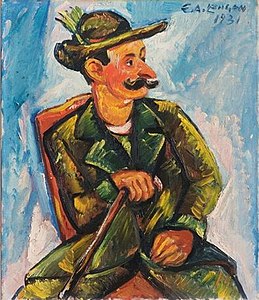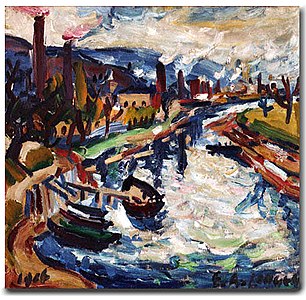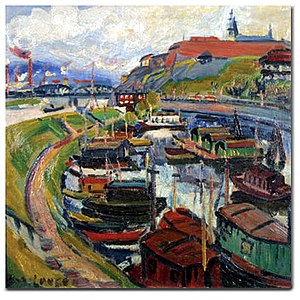Emil Artur Longen
This article needs additional citations for verification. (August 2022) |

(1912, made up for a part)
Emil Artur Longen, born Emil Václav František Pitterman (29 July 1885, Pardubice – 24 April 1936, Benešov) was a Czech playwright, director, actor, screenwriter and painter. He was initially drawn to Post-Impressionism and Expressionism, but was also influenced by Cubism. In addition to painting, he created illustrations and caricatures for various periodicals.
Biography
[edit]His father was a notary, originally from Vlašim.[1] After 1904, he studied at the Academy of Fine Arts, Prague, with František Thiele. In 1907, he participated in founding the artists' association, Osma. He was expelled from the Academy in 1908, for disciplinary infractions.

Although focused on art, he was also attracted to the theater and the cabaret. Around 1909, he began to collaborate with the writer and actor, Eduard Bass. It was then that he first used the pseudonym "Longen". Over the next twenty years, he would become a prominent figure in many Prague cabarets, including the famous Červená sedma (Red Seven). In 1910, he married the actress, Xena Marková.
In 1911, he made his mark at the beginnings of Czech cinema, co-authoring and starring in a series of four short comedies about a bon-vivant named Rudi. He also directed the last film in the series, Rudi Sportsman.
He opened his own cabarets in 1920: Bum (Boom) and Revoluční scéna (The Revolutionary Scene). In 1921, he was in his first full-length silent film; Otrávené světlo (The Poisoned Light), playing a magician opposite Karel Lamač and Anny Ondra. For a time, he also worked abroad; in Paris, Ljubljana and Berlin. Back in Prague in 1925, he and the director, Vladimír Gamza, agreed to merge their theater companies to create a new company named Sečesteal (an acronym for "Spojené ensembly Českého studia E. A. Longena").[2] It was short-lived, however, so he became an actor and dramaturge at the new Vlasta Burian Theater. While there, in 1927, he wrote a biography of the theater's founder, the comedian Vlasta Burian.
Despite his professional successes, his marriage proved to be a very unhappy one. Xena felt disrespected, became depressed, addicted to morphine and cocaine and, in 1928, committed suicide by jumping from a window. Later that same year, he remarried, to Maria Uhlířová, apparently also an actress, and they had two children. He wrote a biographical novel in Xena's honor, called Herečka (Actress)
Since his student days, he had been known for his Bohemian lifestyle and explosive temperament, and was intoxicated almost daily.[citation needed] Much of his considerable income was squandered, and he was perpetually in debt. During the last half of his life, his paintings increasingly came to serve as little more than a way to help pay those debts. He died in 1936, in Beneš Hospital, at the age of fifty, from a perforated ulcer.[1]
Selected paintings
[edit]-
Portrait of Vlasta Burian
-
Factory on the River Bank
-
In the Bar
-
Prague Harbor
-
Captured by Alcohol
(self-portrait)
References
[edit]- ^ a b Jiří Červený: Červená sedma, Orbis, Prague, 1959
- ^ Ladislav Boháč: Tisíc a jeden život, Odeon, Prague, 1981, pg.42
Further reading
[edit]- Various authors, Dějiny českého divadla/IV, Academia, Prague, 1983, pp.;40, 47, 50–52, 96, 158–161, 171–2, 182, 268, 374, 520, 590, 591, 596–7, 603, 611–2, 642, 647–8
- Z. Sílová, R. Hrdinová, A. Kožíková and V. Mohylová : Divadlo na Vinohradech 1907–2007 – Vinohradský ansámbl, vydalo Divadlo na Vinohradech, Prague, 2007, pp204–5 ISBN 978-80-239-9604-3
External links
[edit]- More works by Longen @ ArtNet
- Entry on Longen @ the Česko-Slovenská filmová databáze
- Entry on Longen @ abART
- Emil Artur Longen, Jaroslav Hašek (biography), Beaufort publishing, 1928 (Full text online @ Bohemian Library)
- "Emil Artur Longen brought both Švejk and Lenin to the scene for the first time" by David Hertl @ Český rozhlas





